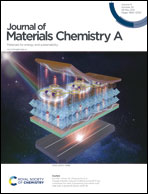Orbital chemistry of high valence band convergence and low-dimensional topology in PbTe†
Abstract
The exceptional thermoelectric performance of PbTe is partially due to the high valley degeneracy, NV, of the band edges. In this paper, we specifically look at the valence band (VB) structure of PbTe, which has been described using a two-band model consisting of a light valence band with a maximum at the L-point in the first Brillouin zone and a heavy band with its maximum along the Σ-line. The light and heavy band extrema are located at low symmetry points, resulting in valley degeneracies of NV = 4 and NV = 12, respectively. The relative energy positions of the light and heavy valence bands can be tuned with temperature and defect concentration to make them effectively converged. In this study, analytical solutions from the tight-binding method are employed to understand the possible orbital interactions that lead to this VB convergence. Both temperature and alloying based methods are explained as means to tailor the VB structure to achieve high valley degeneracy through band convergence. We predict five strategies for tuning valence band convergence: (i) alloying to introduce unfilled cation-s (s0) defect states above valence band edge, (ii) increasing the lattice parameter through alloying or temperature, (iii) alloying to decrease the energy difference between anion-p and anion-s states, (iv) alloying to replace filled Pb-s (s2) states with filled cation-s states that are lower in energy, and (v) decreasing the strength of anion spin–orbit interactions. Furthermore, we find that when the VBs are in a highly converged state, there is a topological transition in the electronic band structure to two-dimensional (2D) and potentially to one-dimensional (1D) character. Assuming acoustic-phonon scattering, we use the Boltzmann transport equation (BTE) to predict a significant enhancement in thermoelectric performance for the 2D and 1D band model, with a theoretical zT > 10 predicted for the 1D topology, ∼20 times greater than that predicted for the 3D topology. Although we specifically discuss PbTe, the qualitative results of this work can be applied to all the IV–VI (IV = Ge, Sn, Pb; VI = S, Se, Te) rock salt compounds.



 Please wait while we load your content...
Please wait while we load your content...